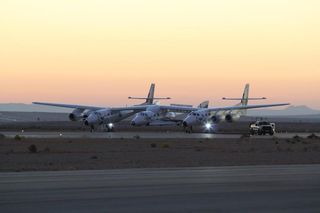Virgin Galactic's SpaceShipTwo Crashes in Test Flight: 1 Dead, 1 Injured
Virgin Galactic's suborbital space plane SpaceShipTwo crashed today (Oct. 31) in California during a rocket-powered test flight that resulted in the death of one pilot and injuries to the other one.
SpaceShipTwo "suffered a serious anomaly" just after its rocket motor ignited for the test flight, leading to the crash of the spacecraft and death of one pilot. Another pilot sustained injuries and was taken to Antelope Valley Hospital. The pilots were with the Mojave, California-based aerospace company Scaled Composites, which built and is testing SpaceShipTwo for Virgin Galactic.
"Space is hard, and today was a tough day," Virgin Galactic CEO George Whitesides said during a news conference today. "We are going to be supporting the investigation as we figure out what happened today, and we're going to get through it. The future rests, in many ways, on hard days like this. But we believe we owe it to the folks who were flying these vehicles as well as the folks who have been working so hard on them to understand this and to move forward, which is what we'll do."

SpaceShipTwo was lofted into the air by its carrier craft WhiteKnightTwo when the pair took off from California's Mojave Air and Space Port at 12:20 p.m. EDT (1620 GMT). The carrier craft then released SpaceShipTwo at 1:10 p.m. EDT, and officials on the ground noticed an "in-flight anomaly" about two minutes later, CEO and general manager of the space port Stuart Witt said during the news conference.
One eyewitness to the event, Doug Messier, managing editor of Parabolicarc.com, saw SpaceShipTwo's engine sputter when it first came to life during the test flight, after WhiteKnightTwo released it.
"It looked like the engine didn't perform properly," Messier told Space.com's Tariq Malik. "Normally it would burn and it would burn for a certain period of time. It looked like it may have started and then stopped and then started again."

Then, Messier saw the ship break apart. "I didn't see an explosion, but it definitely broke into pieces," he added.
Get the Space.com Newsletter
Breaking space news, the latest updates on rocket launches, skywatching events and more!
Virgin Galactic founder Richard Branson is on his way to the Mojave to be with his team now.
"Thoughts with all @virgingalactic & Scaled, thanks for all your messages of support," Branson wrote in an update on Twitter. "I'm flying to Mojave immediately to be with the team."
The exact nature of the problem that caused the crash has not yet been released. "During the test, the vehicle suffered a serious anomaly resulting in the loss of the vehicle," Virgin Galactic representatives said in a statement.
Today's flight was the fourth powered test flight for SpaceShipTwo, and it marked the first time the space plane's rocket motor has been used in flight since January. Virgin Galactic successfully flew an unpowered "glide flight" with SpaceShipTwo earlier this month without starting the rocket engine. The test today was the vehicle's 55th test flight of any kind.
WhiteKnightTwo is designed to take SpaceShipTwo (which holds six passengers and two pilots) up to an altitude of 50,000 feet (15,000 meters). The carrier aircraft is then expected to drop SpaceShipTwo, at which point the spaceliner's rocket comes to life, taking the spaceship into suborbital space.
Currently, rides on SpaceShipTwo (which has not begun flying commercially yet) run for $250,000. More than 700 people have paid for tickets on the vehicle.
Branson licensed the technology for SpaceShipOne — SpaceShipTwo's predecessor, built by Scaled Composites — after SpaceShipOne won the $10 million Ansari X Prize. The prize was awarded after the spaceship became the first private, manned craft to fly to space and back twice in two weeks.
Editor's Note: This story was updated at 6:30 p.m. EDT (2130 GMT) to include new information and quotes. This story is also an updated version of an earlier report here: Virgin Galactic's SpaceShipTwo Spacecraft Crashes During Test Flight
Space.com staff writer Calla Cofield (@callacofield) and managing editor Tariq Malik (@tariqjmalik) contributed to this report from New York City. Follow Miriam Kramer @mirikramer and Google+. Follow us @Spacedotcom, Facebook and Google+. Original article on Space.com.
Join our Space Forums to keep talking space on the latest missions, night sky and more! And if you have a news tip, correction or comment, let us know at: community@space.com.

Miriam Kramer joined Space.com as a Staff Writer in December 2012. Since then, she has floated in weightlessness on a zero-gravity flight, felt the pull of 4-Gs in a trainer aircraft and watched rockets soar into space from Florida and Virginia. She also served as Space.com's lead space entertainment reporter, and enjoys all aspects of space news, astronomy and commercial spaceflight. Miriam has also presented space stories during live interviews with Fox News and other TV and radio outlets. She originally hails from Knoxville, Tennessee where she and her family would take trips to dark spots on the outskirts of town to watch meteor showers every year. She loves to travel and one day hopes to see the northern lights in person. Miriam is currently a space reporter with Axios, writing the Axios Space newsletter. You can follow Miriam on Twitter.
